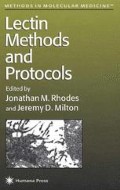Abstract
Resting lymphocytes can be induced to undergo DNA synthesis and subsequently cell division and proliferation by a wide variety of agents, but undoubtedly lectins constitute the most convenient generic group of mitogens to pick off the shelf as reagents. Under the influence of strongly mitogenic lectins, a high proportion of T-lymphocytes (irrespective of T-cell receptor specificity) will differentiate into active cytokine-synthesizing cells (helper cells, predominantly with a CD4-positive phenotype) and/or into cells with a functional suppressor or cytotoxic (both predominantly CD8-positive) capacity. Some resting B-lymphocytes will also become activated and subsequently proliferate and differentiate as fully as plasma cells. Although most work has been done in vitro, there is good evidence that some lectins are also mitogenic in vivo (1)
Access this chapter
Tax calculation will be finalised at checkout
Purchases are for personal use only
References
Kilpatrick, D.C. (1995) Lectins in immunology, in Lectins-Biomedical Perspectives (Pusztai, A and Bardocz, S.,eds.), Taylor & Francis, Basingstoke,UK, pp 155–182
IUIS/WHO Report (1988) Laboratory investigations in clinical immunology methods, pitfalls, and clinical indications. Clin Exp Immunology 74, 494–503.
Penhale, W T, Farmer, A, Maccuish, A C, and Irvine, W. J (1974) A rapid micro-method for the phytohemagglutinin-induced human lymphocyte transformation test. Clin. Exp Immunol 18, 155–167
Maluish, A. E and Strong, D M. (1986) Lymphocyte proliferation, in Manual of Clinical Laboratory Immunology, 3rd ed. (Rose, N R, Friedman, H, and Fahey, J L, eds), American Society for Microbiology, Washington, DC, pp 274–281.
Kilpatrick, D. C (1993) Isolation of lymphocytes and accessory cells for assays of mitogenicity, in Lectins and Glycobiology (Gabius, H-J and Gabius, S, eds.),Springer-Verlag, Berlin, pp. 369–375
Wantyghem, J. Goulut, C., Frenoy, J-P., Turpin, E, and Goussault, Y (1986) Purification and characterization of Robinia pseudoacacia seed lectins Biochem J 237, 483–489
Falasca, A, Franceschi, C, Rossi, C. A, and Stirpe, F (1979) Purification and partial characterization of a mitogenic lectin from Vicia sativa Biochim Biophys Acta 577, 71–81
Lis, H. and Sharon, N (1981) Lectins in higher plants, in The Biochemistry of Plants, vol 6 (Marcus, A, ed), Academic, New York, pp 371–447
Licastro. F, Chiricolo, M., Barbieri, L., and Stirpe, F (1983) Effect of 32 purified animal and plant lectins on human T-lymphocytes, in Lectins/3-Biology, Biochemistry.Clinical Biochemistry, vol 3 (Bøg-Hansen, T-C and Spengler, G A, eds), Walter deGruyter, Berlin, pp 293–302
Falasca, A, Franceschi, C, Rossi, C. A., and Stirpe, F (1980) Mitogenic and hemagglutinating properties of a lectin purified from Hura crepitans seeds Biochim Biophys Acta 632, 95–105
Kilpatrick. D C, Peumans, W J, and Van Damme, E J M(1990) Mitogenic activity of monocot lectins, in Lectins—Biology, Biochemistry, Clinical Biochemistry, vol 7 (Koucourek, J., ed.), Sigma, St Louis, MO, pp 259–263
Avichezer. D and Gilboa-Garber, N (1987) PA-II, The L-fucose and D-mannose binding lectin of Pseudomonas aeruginosa stimulates human peripheral lymphocytes and murine splenocytes FEBS Lett 216, 62–66
Shen, Z-W., Sun, C, Zhu. Z., Tang, X-H, and Shen, R-J (1984) Purification and properties of rice germ lectin Can J Biochem Cell Biol 62, 1027–1032
Tokuyama, H (1973) Isolation and characterization of pokeweed mitogen-like phytomitogens from shoriku, Phytolacca esculenta Biochim Biophys Acta 317, 338–350.
Borrebaeck, C A K and Rougé, P (1986) Mitogenic properties of structurally related Lathyrus lectins Arch Biochem Biophys 248, 30–34
Author information
Authors and Affiliations
Editor information
Editors and Affiliations
Rights and permissions
Copyright information
© 1998 Humana Press Inc.
About this protocol
Cite this protocol
Kilpatrick, D.C. (1998). Use of Lectins as Mitogens for Lymphocytes. In: Rhodes, J.M., Milton, J.D. (eds) Lectin Methods and Protocols. Methods in Molecular Medicine™, vol 9. Humana Press. https://doi.org/10.1385/0-89603-396-1:385
Download citation
DOI: https://doi.org/10.1385/0-89603-396-1:385
Publisher Name: Humana Press
Print ISBN: 978-0-89603-396-2
Online ISBN: 978-1-59259-593-8
eBook Packages: Springer Protocols

